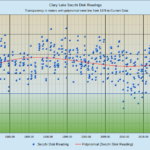Kelsie French and I got out on the lake on Sunday for our biweekly water quality data collection and the results are worth sharing. We had a secchi disk reading (a measure of lake transparency) of 4.18 meters (13.71 feet) which while not unheard of, is actually quite good, especially this time of year, considering all the rain we’ve received this summer. Rain means runoff and runoff means sediment and sediment means Phosphorus and Phosphorus means algae… Two weeks ago it was 3.80 meters (12.46 feet). I didn’t expect to see it improve, but it did! You can see today’s reading on the far right just above the 4 meter line on the above chart. We’re definitely trending in the right direction! You can see a subset of the data we collect back to 2012 on our Clary Lake Water Monitoring Data page.
On the downside, dissolved oxygen (DO) was only 1.1 mg/l at 4 meters which is damned low for such a shallow depth; 2 weeks ago it was 5.4 mg/l at 4 meters and 2.5 mg/l at 5 meters. Today it rapidly fell off from 4 meters and at 7 meters and below we found NO oxygen at all. Under these severely anaerobic conditions, Phosphorus which is normally stored in bottom sediments can reenter the water column. As long as it stays near the bottom, it’s not a problem but in the fall when the lake turns over, this Phosphorus rich water will mix with the upper layers where algae live, and this can spur out of control algae growth. This is why most severe algae blooms occur in the fall. The bloom we had last fall was in part due to this phenomena. There were other extenuating circumstances.
We also took the first of 3 core water samples we’ll take this season for Phosphorus testing. We’ll take another in mid-August and a 3rd in mid-September.
Right now, the water quality in Clary Lake is very good but that may change this fall. Time will tell.

